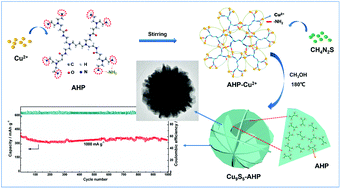Constructing hyperbranched polymers as a stable elastic framework for copper sulfide nanoplates for enhancing sodium-storage performance†
Abstract
Electrochemical conversion reactions offer a new avenue to build high-capacity anodes for sodium-ion batteries. However, poor long-term cyclability and low coulombic efficiency at the first cycle remain a significant challenge for practical Na-ion battery applications. Herein, a novel hyperbranched polymer is used as a template and electrode additive to construct unique hierarchical Cu9S5 nanoplates. With an internal uniform distribution, the additive could regulate the morphology and microstructure of Cu9S5 and offer a buffering matrix to alleviate nanoparticle aggregation and enhance solid-state Na+ ion diffusion. This Cu9S5 composite anode exhibits a high reversible capacity of 429 mA h g−1 at 100 mA g−1, a high coulombic efficiency of 94.3% at the first cycle, a superior rate capability of 300 mA h g−1 at 20 A g−1, and an outstanding cyclability with 82.2% capacity retention after 1000 cycles. The kinetic study reveals that Cu9S5–AHP nanoplates show a low charge transfer resistance and high Na+ diffusion coefficient (∼10−9 cm2 s−1). The present work suggests a potentially feasible anode material for sodium-ion batteries and, more significantly, demonstrates a novel strategy for the construction of high-performance conversion materials for sodium-ion batteries.



 Please wait while we load your content...
Please wait while we load your content...